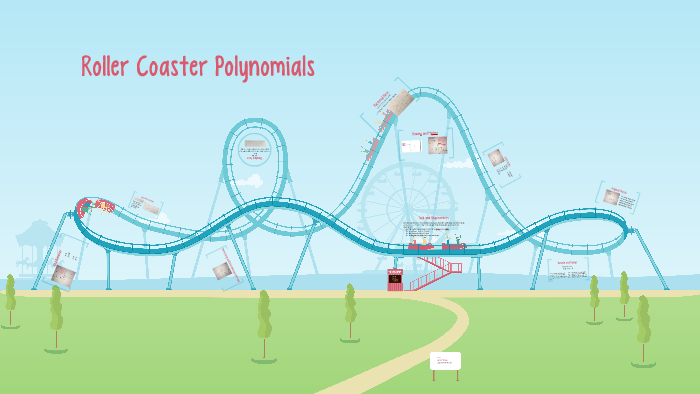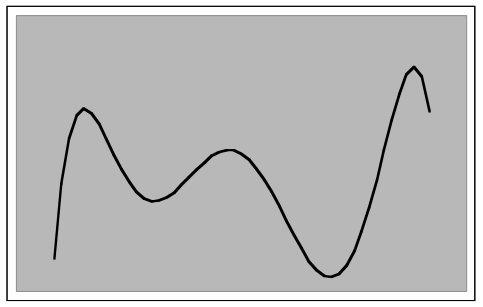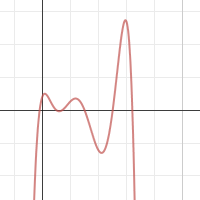DUE on Friday February 14th 2014 You decided to become a structural engineer who specializes in roller coaster design. The brochure for the coaster says that for the first 10 seconds of the ride the height of the coaster can be determined by ht 03 t3 5t2 21 t where t is the time in seconds and h is the height in feet.

Grace Thomas Roller Coaster Polynomials By Grace T
INDIVIDUAL Roller Coaster Design You will design your own roller coaster polynomial using the skills learned during the small group application problems.

. Ray says the third-degree polynomial has four intercepts. These modules involve a mathematical definition of thrill and calculation of thrill for several real coasters Module A design and thrill analysis of single-drop coaster hills Modules B and C and design and. Weight 2 Gift Grades 1 grade for application problems and 1 grade for your own roller coaster ride model Purpose.
April 29 2020 Purpose. This polynomial is a cubic trinomial 2. Be sure to illustrate your x-axis and y-axis scale to identify the length of the ride and the height of the designing.
In real life polynomial functions are used to design roller coaster rides. In this module you will model a straight-stretch coaster several hills by marking n peak and valley points and then fitting in height and slope n - 1 cubic polynomial functions one to each consecutive pair of marked points. Up to 24 cash back 1.
INDIVIDUAL Roller Coaster Design You will design your own roller coaster polynomial using the skills learned during the small group application problems. Your work MUST be neat organized and must appear proftessional 1. Graph the polynomial function for the height of the roller coaster on the coordinate plane at.
Up to 24 cash back In real life polynomial functions are used to design roller coaster rides. Keep the enjoyment factor of the passenger in mind as you complete your design. Use your imagination and have fun with this project.
In this project you will complete a series of modules that require the use of polynomial and trigonometric functions to model the paths of straight stretch roller coasters. Part A The first part of Ray and Kelseys roller coaster is a curved pattern that can be represented by a polynomial function. The roller coaster MUST represent the teams polynomial function.
Your project will be assessed based on the following general criteria. Design of a Thrilling Roller Coaster - Module E. Classify this polynomial by degree and by number of terms.
In this project you will apply the information from Chapter 3 to analyze roller coaster polynomial functions and to design your own roller coaster. Pre-Calculus GIFT 2. As part of their internship they get to assist in the planning of a brand new roller coaster.
Your job is to design your own roller coaster ride. Up to 24 cash back ROLLER COASTER POLYNOMIALS INDIVIDUAL ROLLER COASTER DESIGN. Application Problems You will have to answer.
Classify this polynomial by degree and by number of terms. Your project will be assessed based on the following general criteria. Application Problems ONE GROUP ANSWER SHEET will be graded on correctness and accuracy of the answers.
Design of a Coaster. The team will have to supply its own materials. Option 1Individual Roller Coaster Crew Ray and Kelsey have summer internships at an engineering firm.
In this project you will apply skills acquired in Unit 2 to analyze roller coaster polynomial functions and to design your own. In real life polynomial functions are used to design roller coaster rides. The brochure for the coaster says that for the first 10 seconds of the ride the height of the coaster can be determined by ht 03t3 5t2 21t where t is the time in seconds and h is the height in feet.
Ray and Kelsey are working to graph a third-degree polynomial function that represents the first pattern in the coaster plan. Up to 24 cash back 1. INDIVIDUAL Roller Coaster Design You will design your own roller coaster polynomial using the skills learned during the small group application problems.
Part A The first part of Ray and Kelseys roller coaster is a. To complete this task please follow these steps. Ray and Kelsey are working to graph a third-degree polynomial function that represents the first pattern in the coaster plan.
Draw a rough sketch of your roller coaster ride on a coordinate plane Note. Dimensions are not to exceed. Up to 24 cash back you must show the polynomial function Roller Coaster Design.
Ihe roller coaster MUST be built on a base. Your project will be assessed based on the following general criteria. Part A The first part of Ray and Kelseys roller coaster is a curved pattern that can be represented by a polynomial function.
Graph the polynomial function for the height of the roller. The design report must be clearly labeled with the answers to all 10 of the questions. For this assignment you help Ray and Kelsey as they tackle the math behind some simple curves in the coasters track.
Up to 24 cash back Part 2. Application Problems ONE GROUP ANSWER SHEET. Application Problems ONE GROUP ANSWER SHEET.
In this project you will apply skills acquired in Unit 2 to analyze roller coaster polynomial functions and to design your own roller coaster. ROLLER COASTER POLYNOMIALS Due Date. Make sure your design meets all the criteria listed above ride you are 2.
You will place your roller coaster design on one-half of a standard-sized white poster board. The team will have to.

Alex S Roller Coaster Creating A Polynomial Function Youtube

Polynomial Roller Coasters The Futures Channel

Need Help With A Roller Coaster Project R Learnmath

Alex S Roller Coaster Creating A Polynomial Function Youtube

Polynomial Roller Coaster Contains Intentional Error Youtube

0 comments
Post a Comment